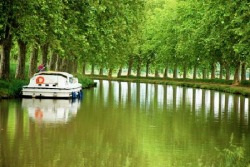Boat trips on the Canal Du Midi

HistoryThe Canal du Midi basin at CastelnaudaryThe Canal du Midi, south of Toulouse, with a typical small boat.The Canal du Midi, approaching the round lock at Agde. Note the tow path along the Canal.World's first canal tunnel, at MalpasSeven connected locks at Fonséranes, BéziersThe original purpose of the Canal du Midi was to be a shortcut between the Atlantic and the Mediterranean, avoiding the long sea voyage around hostile Spain, Barbary pirates, and a trip that in the 17th century required a full month of sailing. The strategic value of this is obvious and it had been discussed for centuries, in particular when King Francis I brought Leonardo da Vinci to France in 1516 and commissioned a survey of a route from the Garonne at Toulouse to the Aude at Carcassonne. The major problem that this and subsequent planners had during the next 150 years was how to supply the summit sections with enough water.
This was the problem that Pierre-Paul Riquet, a rich tax-farmer in the Languedoc region, who knew the region intimately, believed in 1662 that he could solve. He first had to persuade Jean-Baptiste Colbert, the finance minister of Louis XIV which he did through his friendship with the Archbishop of Toulouse. A Royal Commission was appointed and in 1665 recommended the project which was finally ordered by Louis XIV in 1666 with the possible expenditure of 3,360,000 livres.
So at the age of 63, Riquet started on his greatest work by commissioning his engineer, François Andreossy to build a huge dam at Saint Ferréol on theLaudot river, a tributary of the River Tarn in the Montagne Noire some 20 km (12 mi) from the summit of the proposed canal at Naurouze. This massive dam, 700 metres (2,300 ft) long, 30 metres (98 ft) above the riverbed and 120 metres (390 ft) thick at its base was the largest work of civil engineering in the century in Europe and only the second major dam to be built in Europe, after one in Alicante in Spain. This was Riquet's unprecedented plan to supply the canal with water. He connected this newly built body of water, the Bassin de St. Ferréol, to the summit with a contoured channel over 25 km long, 3.7 m (12 ft) wide with a base width of 1.5 m (4.9 ft) and even constructed 14 locks in it in order to bring building materials for the canal. At peak there were 12,000 labourers on the whole project including 600 women[1].
The actual canal was built on a grand scale with locks of length 30.5 m (100 ft) oval in construction, being 6 m (20 ft) wide at the gates and 11 m (36 ft) wide in the middle. This was intended to resist the collapse of the walls as happened early in the project when he was using deeper locks, but the design's success is dubious and it has not been copied in other canals. Many of the structures were ornate and survive to this day.
The Canal du Midi was opened officially as the Canal Royal de Languedoc on May 15, 1681. It was also referred to as the Canal des Deux Mers (Canal of Two Seas). It eventually cost over 15 million livres, of which nearly 2 million came from Riquet himself, leaving him with huge debts and he died in 1680, just months before the Canal was opened to navigation. His sons inherited the canal, but the family's investments were not recovered and debts not fully paid for until over 100 years later. The canal was well tended and run as a paternalistic enterprise until the revolution.
[edit]Characteristics of the CanalThe Canal has 91 locks which serve to climb and descend a total of 190 metres (620 ft). The Canal has 328 structures, including not only the locks but also bridges, dams and a tunnel.
At the town of Béziers there was a staircase of 8 locks at Fonsérannes to bring it to the river Orb. Because of flooding problems, a pont-canal(aqueduct) was later built bypassing the bottom two locks. In 1982/3, a water slope was built for barges alongside, though it is now rarely used.
The design of the Canal included the first canal passage ever built through a tunnel (the Malpas Tunnel). The Canal du Midi passes through a 173-metre (570 ft) long tunnel through a hill at Enserune.
The Canal also involved building the first artificial reservoir for feeding a canal waterway, the Reservoir de St. Ferréol.
The construction of the Canal du Midi was considered by people in the 17th century as the biggest project of the day. Even today, it is seen as a marvelous engineering accomplishment and is the most popular pleasure waterway in Europe.
Initially the canal appears to have been mainly navigated by small sailing barges with easily lowered masts, bow-hauled by gangs of men. By the middle of the 18th century, horse towing had largely taken over and steam tugs came in 1834 to cross the Étang. By 1838 there were 273 vessels regularly working the canal and passenger and packet boats for mail continued a brisk trade until the coming of the railways in 1857.[2] Commercial traffic continued until 1980 when it began to decline rapidly, ultimately ceasing altogether during the drought closure of 1989.
